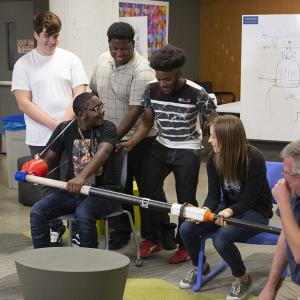When Jimmil Campbell first enrolled in Cleveland Metropolitan School District’s School of One at The Foundry, Cleveland’s community rowing and sailing center, he faced a unique challenge.
Having lost the fingers on his right hand to an infection as an infant, the now-high-schooler worried his disability would prevent him from taking part in “The Foundry Experience”—an hour of daily lessons in physical activities such as rowing.
Campbell’s best friend, Mario Hull, had other plans. Hull drew sketches of a proposed prosthesis—one that would attach to the end of an oar and allow Campbell to row with his peers.
“Our curriculum is designed to study real-world problems in an engaging and individualized way,” said teacher Melanie Lynch. “We felt, what better problem to tackle than this?”
Lynch connected with Richard Graham, outreach coordinator at Larry Sears and Sally Zlotnick Sears think[box], Case Western Reserve’s center for innovation and entrepreneurship, to design a weeklong course for the students to investigate and prototype end-effector mechanisms for rowing. With the help of Sears think[box] staff and biomedical engineering professors, the students learned iterative design processes and programs like computer-aided design to create two initial prototypes that they plan to continue refining at Sears think[box] during the school year.
Though the prototypes are still a work in progress, the students can’t wait for Campbell to start trying them on the water.
“I always want to feel equal to people; I don’t want to feel different,” said Campbell, who also participates in the university’s Upward Bound Program for low-income and potential first-generation college students. “I just want to thank everyone involved in this project for helping make my dream come true.”


